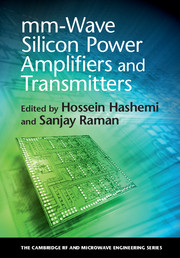Book contents
- Frontmatter
- Contents
- List of Contributors
- Preface
- 1 Introduction
- 2 Characteristics, performance, modeling, and reliability of SiGe HBT technologies for mm-wave power amplifiers
- 3 Characteristics, performance, modeling, and reliability of CMOS technologies for mm-wave power amplifiers
- 4 Linear-mode mm-wave silicon power amplifiers
- 5 Switch-mode mm-wave silicon power amplifiers
- 6 Stacked-transistor mm-wave power amplifiers
- 7 On-chip power-combining techniques for mm-wave silicon power amplifiers
- 8 Outphasing mm-wave silicon transmitters
- 9 Digital mm-wave silicon transmitters
- 10 System-on-a-chip mm-wave silicon transmitters
- 11 Self-healing for silicon-based mm-wave power amplifiers
- Index
- References
1 - Introduction
Published online by Cambridge University Press: 05 April 2016
- Frontmatter
- Contents
- List of Contributors
- Preface
- 1 Introduction
- 2 Characteristics, performance, modeling, and reliability of SiGe HBT technologies for mm-wave power amplifiers
- 3 Characteristics, performance, modeling, and reliability of CMOS technologies for mm-wave power amplifiers
- 4 Linear-mode mm-wave silicon power amplifiers
- 5 Switch-mode mm-wave silicon power amplifiers
- 6 Stacked-transistor mm-wave power amplifiers
- 7 On-chip power-combining techniques for mm-wave silicon power amplifiers
- 8 Outphasing mm-wave silicon transmitters
- 9 Digital mm-wave silicon transmitters
- 10 System-on-a-chip mm-wave silicon transmitters
- 11 Self-healing for silicon-based mm-wave power amplifiers
- Index
- References
Summary
Advancements in semiconductor technology have led to a steady increase in the unity power gain frequency (fmax) of silicon transistors, both in CMOS and SiGe BiCMOS technologies. This, in turn, enables realization of complex monolithic silicon integrated circuits operating at the millimeter-wave (mm-wave) frequency range (typically defined as 30–300 GHz). Prime target applications of silicon mm-wave integrated systems include high-speed wireless access, satellite communications, high-resolution automotive radars, and imagers for security, industrial control, healthcare, and other applications. However, scaling of silicon transistors for high fmax comes at the expense of reduced breakdown voltages, and hence limitations on output voltage swing and power. The link range and energy consumption of wireless systems are direct functions of the transmitter output power and efficiency, respectively. Efficient generation and amplification of radio-frequency (RF) modulated waveforms using silicon transistors is an ongoing challenge due to the reduced breakdown voltage of scaled silicon transistors, loss of passive components, and the conventional linearity–efficiency trade-off. This book covers the fundamentals, technology options, circuit architectures, and practical demonstrations of mm-wave wireless transmitters realized in silicon technologies.
Why mm-waves?
The main motivation to operate the wireless systems at higher carrier frequencies is the larger available bandwidth which translates to higher data rate in communication systems and higher resolution in ranging and imaging systems. Furthermore, the size of the antenna and circuitry, typically proportional to the wavelength, reduces with increasing carrier frequency. On the other hand, operating at higher frequencies poses two fundamental challenges. First, the loss of most materials increases with the frequency; therefore, compared with radio and microwave frequencies (below 30 GHz) the electromagnetic wave at mm-wave frequencies is attenuated more as it propagates in an environment (Fig. 1.1). It should be noted that over the mm-wave spectrum there are “windows” of relatively lower attenuation around 35 GHz, 90 GHz, 140 GHz, etc., and, consequently, these bands are often selected for mm-wave applications; on the other hand, high atmospheric attenuation levels around frequencies such as 60 GHz enable more aggressive frequency reuse, and are therefore often selected for small cell or secure communications applications. Second, the performance of semiconductor devices worsens with frequency; this includes reduced gain, increased noise, and more nonlinearity at higher frequencies for a given technology.
- Type
- Chapter
- Information
- mm-Wave Silicon Power Amplifiers and Transmitters , pp. 1 - 16Publisher: Cambridge University PressPrint publication year: 2016

